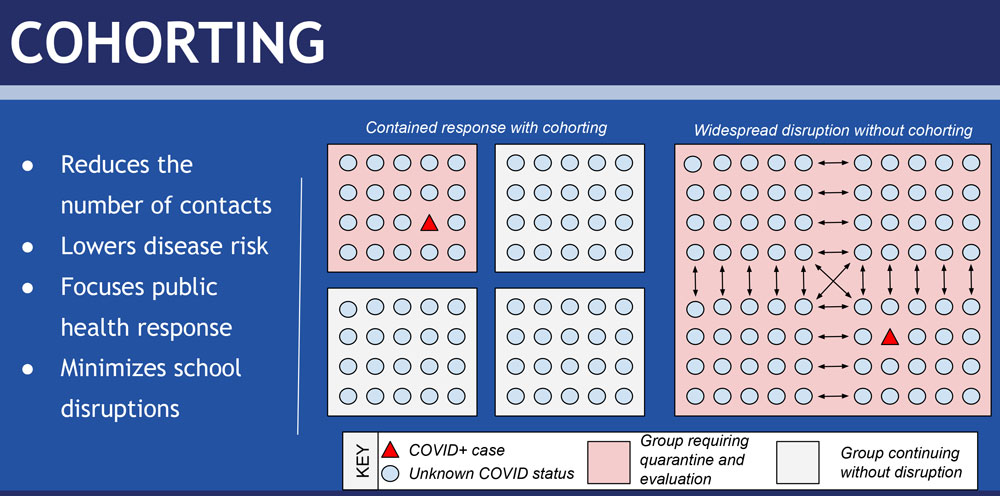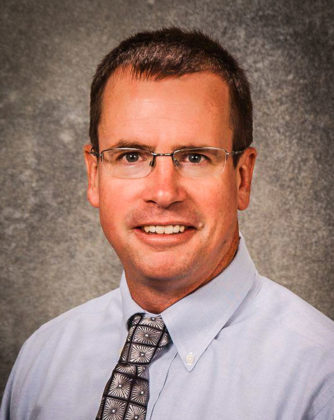
Cohorting reduces the risk of exposure to Covid-19 while also facilitating contact tracing. If a positive case is identified, just those 30 kids will have to go home and get tested and quarantined. Graph from the Colorado Dept. of Public Health and Environment.
If you were listening carefully on July 17, you could almost hear the city-wide moan as DPS announced its decision to postpone in-person learning until at least after Labor Day. Following remote learning in the spring and a long hot summer, everyone seemed eager to return to the classroom. DPS administration continues to work on the details of what the year will look like. Starting July 27, parents were asked to select a learning track: a remote, in-person, or hybrid model.
“There is no right decision. There is no good decision,” says Shelby Dennis, principal of Swigert International School. “I think our biggest challenge, at least at the elementary level, is thinking about working families that have younger kids who aren’t able to stay home.” She appreciates that along with crucial academic content, schools fulfill vital social and emotional needs that cannot be fully met through an online platform. As a parent herself, she says: “The challenge is parents are having to make decisions without all the information.”

Children’s Hospital pediatrician and infectious disease specialist Dr. Sean O’Leary.
Dr. Sean O’Leary, who helped author the American Academy of Pediatrics recommendations released in June, agrees that “the downside of not having kids in school is enormous.” A pediatric infectious disease specialist who works at the University of Colorado School of Medicine and Children’s Hospital, he says, “You will never be at zero risk until there’s a really effective vaccine and we’ve eliminated the virus.” Still, if the virus is “circulating at a very low level—or ideally, not at all—within a community, then that’s where I think that with risk mitigation measures, it’s relatively safe to open schools.”
O’Leary encourages parents to look at the daily updates provided by the Colorado Department of Public Health and Environment (CDPHE), and to specifically consider the hospitalization rate and the “percent positive” rate in testing. Denver reported a positive test rate of 3% for much of June; it went up to 4.5% in mid-July; and averaged 4.3% in the week prior to July 23. O’Leary believes ideally this figure would be 5% or below. “I think if we can drive the infections down to a manageable level where we have adequate testing capacity and good contact tracing, we can have some semblance of normality within our schools.” A father of two, he also is watching the numbers and is planning to send his kids to in-person learning.
In a July Zoom conference, the CDPHE’s Dr. Brian Erly stressed that “cohorting is essential” to any in-person learning. Cohorting reduces the risk of exposure to Covid-19 while also facilitating contact tracing. Kurt Dennis, principal of McAuliffe International School adds, “When you have to shut down, you’re only shutting down that one cohort of kids; just those 30 kids will have to go home and get tested and quarantined, whereas if that student has been traveling around the building and had classes with multiple cohorts and even lunch with their friends,” it would be a much more comprehensive school closure.
A DPS planning document earlier this summer proposed that secondary (middle and high) school students learn in cohorts of up to 30 students each, and interact with up to 4 cohorts. The recent uptick in Covid-19 cases in Denver, however, may impact how many teachers will return to classrooms in person—information administrators need to begin creating student cohorts.
In mid-July, DPS announced $4.9 mill. in HVAC upgrades across the district. Seven companies will undertake the monumental task of assessing and cleaning ventilation systems at over 150 buildings district-wide, including upgrading air filters to mitigate the spread of the novel coronavirus. “We’re exploring the possibility of moving classes outside, if we can do it safely and we have the resources to purchase shade structures,” says Kurt Dennis. Even in a new building, Shelby Dennis says, “Air-conditioned rooms aren’t the best either with Covid…we’re really limited as to what windows we can open and how much.”
In addition to keeping on top of the numbers and talking with their pediatricians, O’Leary encourages parents to talk with school leadership to better understand school policies and mitigation measures. “I don’t think DPS will open schools if we’re in a bad place at that time,” he says. “No one is taking this virus lightly.”




0 Comments